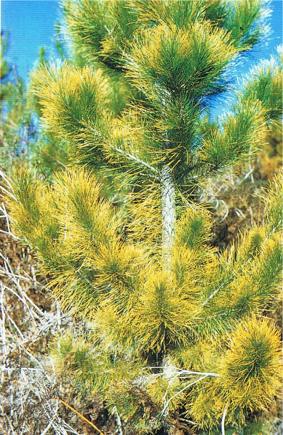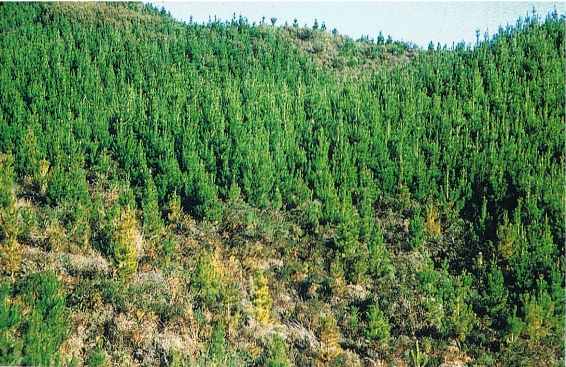PESTS AND DISEASES OF FORESTRY IN NEW ZEALAND
Root rot caused by Rosellinia aff. necatrix
From Scion publication Forest Research Bulletin 220, An Introduction to The Diseases of Forest and Amenity Trees in New Zealand, G.S.Ridley and M.A. Dick 2001.
Species: Rosellinia aff. necatrix (Ascomycete)
Common name: New Zealand white root rot
Country of origin: Origin unknown
Host(s): Infects pine species, eucalypts, other tree species, and various native shrubs. Fruit orchards planted on former native forest or scrubland may also become diseased.
Symptoms: Tips of needles all over the crown develop a golden yellow coloration and this progressively spreads back along the needles towards the base (Fig. 85); on affected trees crown symptons are seasonal, disappearing between midsummer and autumn; affected trees become stunted; affected trees occur singly or ir groups covering up to 0.5 ha (Fig. 86), with surrounding shrub species also occasionally being diseased; roots and root collar become cankered and exude resin.
Disease development: Apparently occurs naturally in native forest and scrubland after clearance. Pines planted on such sites become infected and diseased, with small numbers of badly infected young trees dying. More vigorous trees grow out of the condition. Subsequent development on these sites is unknown.
NZ distribution: Occurs only in the North Island.
Economic impact: Comparatively minor. Formerly this disease caused occasional severe losses in fruit orchards and potato crops on planted scrubland and sites cleared of native forest; it is recorded as a minor parasite on pine as early as 1896.
Control: Not considered necessary.
References: Gilmour 1966

Fig. 85: Needle tip yellowing of Pinus radiata induced by Rosellinia aff. necatrix

Fig. 86: Typically, Pinus radiata infected by Rosellinia aff. necatrix occur singly or in groups covering up to 0.5 ha

 Farm Forestry New Zealand
Farm Forestry New Zealand

